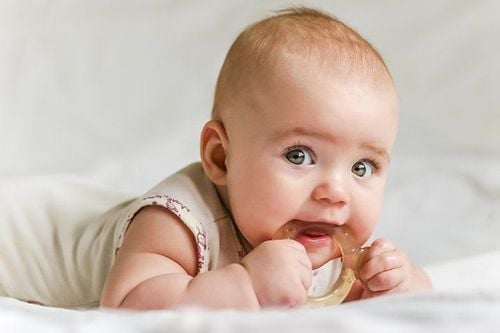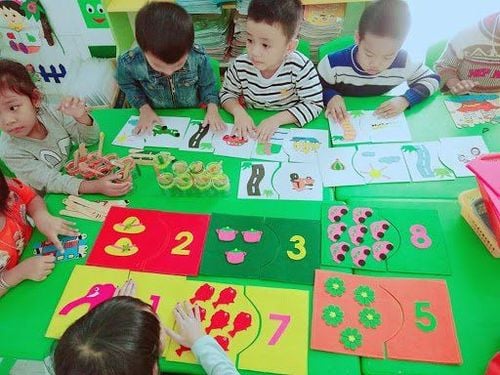This is an automatically translated article.
The article was consulted with Master, Doctor Nguyen Thi An - Pediatrician - Neonatologist - Department of Pediatrics - Neonatology - Vinmec Ha Long International General Hospital.Healthy eyes and good vision play an important role in a child's development. A child's vision gets better over time. This improvement in vision is necessary so that children can explore the world more fully and start school.
1. How far can babies see
At birth, infants cannot see as well as adults, their eyes and visual systems are not fully developed. But your baby's eyesight improves dramatically in the first few months of life. Not all children develop the same, and some children may reach certain developmental milestones at different times.Some milestones to note for the development of vision in young children:

Khi mới sinh, trẻ sơ sinh có đôi mắt và hệ thống thị giác của trẻ chưa phát triển đầy đủ
1.1. Newborn to 4 months old
At birth, your baby's vision is quite poor, although he can perceive light, shapes, and movement. Newborns can only see about 8 to 15 inches (20 - 38cm), just far enough away to see the face of the person holding the baby. In other words, your face is the most interesting thing to your baby at this age. So be sure to give yourself plenty of time to look at each other.Immediately after birth, babies see only black and white, with shades of gray. Although children can stare at a high-contrast target such as a black and white concentric pattern, the checkerboard and concentric circle have contrasting colors. But babies are not yet able to tell the difference between two targets or between two moving images in front of their eyes.
During the first months of life, a baby's eyes begin to work together and vision improves rapidly. Eye-hand coordination begins to develop as babies begin to follow moving objects with their eyes and reach for them with their hands. At 8 weeks, it's easier for babies to focus on the faces of their parents and other people near them.
By 1 - 2 months old, your baby will learn to focus both eyes and be able to follow a moving object left and right, although he may already be able to do this for a short time. from birth.
You can play games with your baby's eyes by getting very close to the baby's face and slowly moving his head from side to side. Usually, your baby's eyes will be fixed on you.
Starting at 2 months of age and continuing through the fourth month, the color difference will become more obvious to the baby. Your baby will begin to distinguish similar colors like red and orange. As a result, children may begin to show an interest in bright primary colors and more detailed and intricate designs and shapes. You can encourage this by showing your child bright pictures, pictures, books, and toys.
1.2. Children from 5-8 months old
As your baby passes the 5 month mark, she'll get better at spotting very small items and will begin to tell the difference between pastels. By 8 months, your baby's vision is good enough to recognize people and objects in the room.During these months, your baby's ability to control eye movements and eye-body coordination skills continue to improve.
Babies begin to perceive spatial depth, the ability to judge whether objects are nearer or further away than other objects, which is not present at birth. It is not until about the fifth month that the eyes are able to work together to form a three-dimensional view of the world and begin to see in depth.
Although the color perception of infants is not as sharp as that of adults, it is believed that infants have good color discrimination by the age of 5 months.
Most babies start crawling around 8 months of age, which further develops eye-hand-foot-body coordination. Toddlers who are not yet crawling may not learn to use their eyes together as much as babies who crawl.
1.3. Children from 9 to 12 months old
At around 9 months of age, babies begin to learn to stand up on their own. At 10 months old, your baby can grasp objects with thumb and index finger.By twelve months, most babies will crawl and try to walk. Parents should encourage children to learn to crawl rather than to walk early to help children develop better hand-eye coordination. Children this age can judge distances fairly well and throw objects accurately.
1.4. Children from 1 to 2 years old
By the age of 2, children's eye-hand coordination and depth perception will be well developed.Children this age are very interested in exploring their environment, using their eyes to see and ears to listen. Children can recognize familiar objects and images in books and can scribble with crayons or pencils.
2. Signs of eye and vision problems in children
The presence of eye and vision problems in infants is very rare. Most babies start life with healthy eyes and develop visual abilities without difficulty. But sometimes, vision and eye health problems can develop. Parents need to watch out for the following signs, which can be signs of eye and vision problems in their children, signaling that their child needs to be examined soon:Heavy tearing can be caused by a blocked tear duct. occlusion. Red or swollen eyelids can be a sign of an eye infection. Constant eye roll can signal a problem with eye muscle control. Hypersensitivity to light can indicate elevated pressure in the eye. The appearance of a white pupil may indicate the presence of eye cancer. The presence of any of these signs means that your child needs to be checked by an ophthalmologist right away.

Sự hiện diện của các vấn đề về mắt và thị lực ở trẻ sơ sinh rất hiếm khi xảy ra
3. What parents can do to help develop their children's eyesight
There are many things parents can do to help their baby's vision develop properly. Here are some examples of age-appropriate activities that can support a child's visual development:For babies up to 4 months, parents can do the following:
Use Use a night light or other dim light in the baby's room. Change the crib position often and change the baby's position in it. Keep toys accessible and within your baby's line of sight, about 8 to 12 inches. Talk to your baby as you walk around the room. Alternate feeding positions from right to left and vice versa. For children aged 5 to 8 months, parents can do the following:
Hang a portable device, exercise cot or various objects on the crib for baby to grasp, pull and kick. Give your baby plenty of time to play and explore on the floor. Provide plastic or wooden blocks that children can hold in their hands. Play other games, moving your baby's hands in motion while saying related words aloud. For children aged 9 to 12 months, parents can do the following:
Play hide-and-seek with toys or your face to help your baby develop visual memory. Name objects in conversation to encourage word association and vocabulary development. Encourage your child to crawl and climb. For children 1 to 2 years old, parents can do the following:
Roll a ball back and forth to help children track objects with their eyes. Let your child play with building blocks and balls of all shapes and sizes to improve fine motor skills and size discrimination. Read or tell stories to stimulate children's imagination and set the stage for later learning and reading skills. Newborns are born with the full visual capacity to see objects and colors. However, babies cannot see far, they can only see objects 8-15 inches (20 - 38cm) away with the two primary colors of black and white. Children's vision will improve over time, until the child is 2 years old, the ability to observe and coordinate between eyes and parts of the body is almost like that of an adult.

Trẻ sơ sinh không thể nhìn xa, chúng chỉ thấy những vật cách xa 8-15 inch
For children to be healthy and develop well, it is necessary to have a nutritious diet in terms of quantity and quality balance. If children are not provided with adequate and balanced nutrients, it will lead to diseases of excess or lack of nutrients, which adversely affect the comprehensive development of children in terms of physical, mental and motor skills.
Children who do not eat properly are at risk of micro-mineral deficiency causing anorexia, growth retardation, malabsorption,... If they notice the above signs, parents should supplement their children with products. The supplement contains lysine, essential micro-minerals and vitamins such as zinc, chromium, selenium, and B vitamins to help fully meet the nutritional needs of children. At the same time, these essential vitamins also support digestion, enhance nutrient absorption, help improve anorexia, and help children eat well.
Parents can learn more:
Signs of zinc deficiency in children
Micronutrient deficiency and failure to gain weight in children
Please regularly visit Vinmec.com website and update useful information to take care of your child. Take care of the baby and the whole family.
References: babycenter.com, healthychildren.org, webmd.com













